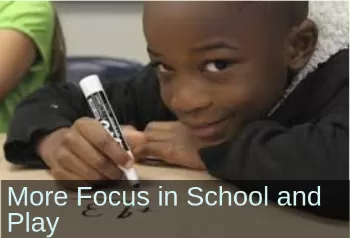Primitive Reflex Integration Case Studies
"His Mother Was In Shock"
OT and mom see progress in anxious boy's focus, behavior with peers, and rhythm
This OT started rhythmic movements and reflex integration with her client, unsure whether these techniques could help but willing to give it a try. She was happily surprised when she used the 5-Step Balance process to help him successfully complete a task they had been working on for a while without much previous progress. "The changes were undeniable."
Submitted by Amy Klassen, OTA

| Before | After |
|---|---|
| Issues with anger management and social skills | Playing better on the playground |
| Could not recite letters to a beat | Is now able to stay on beat |
Toby (name changed) is a fun, outgoing 7-year-old boy who presented to our clinic with oculomotor dysfunction, accommodative insufficiency, convergence insufficiency and laterality challenges. Toby has a history of a C-Section birth and army crawling rather than creeping as a toddler. He is a very caring, sensitive boy, but around the age of 5 began to show signs of anxiety and above average fight/flight response. He ended up hurting a couple of people and has since been seeing a mental health counselor for anger management and social skills.
Throughout our therapy, I noticed that Toby balks at a metronome or any kind of rhythm. After trying an activity with the metronome, Toby told me “the tick surprises me every time”. He also said after a different activity with a metronome “I’m not used to something telling me when to do something; I have to do it how I want to”. These kinds of activities have resulted in lots of frustration, and mom reported practicing at home once resulted in him throwing his vision therapy binder across the room.
I assigned PACE [from the Brain and Sensory Foundations course] to Toby. He immediately liked it and he had the great idea of showing his teacher and his counselor so that they could remind him to do it when he was getting upset. His mom said they also use it at home to replace a “cool down time” if he’s getting worked up. His parents have also been doing the rhythmic movements with Toby each evening, which I assigned to help his body understand rhythm on a much deeper level. I am also working on exercises for the Moro reflex, as I believe his trouble with the metronome, as well as loud sounds in general, is likely sensitivity from a retained Moro reflex.
I did a 5 Step Balance with Toby. His goal was to read a letter chart to the beat of a metronome. For weeks, we have worked on this and his ability to complete this task had improved very slightly, if at all. On the day we tried the 5 step balance, he [initially] read 2 lines from the chart, and like usual, was quite off beat and couldn’t get into a rhythm. After he was done that, I, Toby and Toby’s mother all made a loud clap sound together (with his permission) to stimulate the auditory Moro. Then, all 3 of us got down on the floor and spent a few minutes just moving around pretending to be bucking horses, slithering snakes, etc. Then we stood back up and Toby did hookups with some deep breaths. Then it was time to return to the task. I turned the metronome to the same speed as earlier, but this time Toby did an AMAZING job of following the beat. Even when he had to pause to cough, within 2 letters he was right back on beat! His mother was in shock. She watched him do this with her mouth wide open and was so, so excited once he finished. It was such an incredible difference from all the other times we had tried it.
Toby’s case has been the one that I think has taught me the most. While going through this course I of course found the information fascinating and it sounded wonderful. However I am quite a critical thinker, so although it sounded amazing and what Sonia explained corresponded with what I felt while I did the movements, I needed to experience the results in the children that I worked with to really be sold on it. It all clicked when I saw Toby’s 5 Step Balance. The changes were undeniable. For now, we are putting much more emphasis on reflexes and rhythm in Toby’s therapy. I use mostly the games and developmental movements from the course manual to work on keeping therapy fun and playful while working on the areas that frustrate Toby. We also do core strengthening activities. Toby’s mom has mentioned that since we started working with his reflexes, his teachers have noticed he is more focused in school and his playground play is improving.
[Edited for brevity, emphasis added]
*Disclaimer: The activities in the Brain and Sensory Foundations curriculum make use of the natural processes of neuroplasticity and development that are innately wired in the design of human beings to promote maturity and function. These activities appear to calm, organize, and mature the neuro-sensory-motor systems just as we see in the healthy development of human infants. Individual results may vary, and we do not claim to offer a diagnosis or cure for any specific condition or disorder. The Brain and Sensory Foundations activities appear to improve overall functioning resulting in measurable improvements for a range of conditions as demonstrated in over 1800 case studies from participants.

